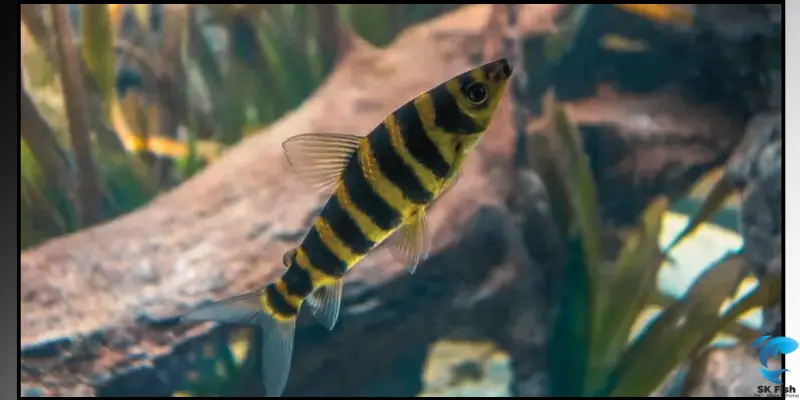Tiger Knife Fish | Complete Aquarist’s Guide to Keeping Them
Published: 15 Apr 2024
Welcome, aquarium enthusiasts! In this blog, we explore the fascinating world of tiger knife fish. Discover amazing facts about this incredible freshwater fish, known for their sleek, long body adorned with vibrant stripes, reminiscent of a tiger’s coat.
Looking for guidance on caring for tiger knife fish in captivity? Look no further! You will find all the crucial care guides for keeping tiger knife fish in your home aquarium here. Let’s start exploring more.
What is Tiger Knife Fish?
The scientific name of the tiger knife fish is Gymnotus Pantherinus. Native to South America, particularly Colombia, and also found in the Amazon regions of Peru and Brazil, this species is renowned for its unique body pattern and colors, making it a popular choice among aquarists.

Common Names
Tiger knife fish is known by various names such as:
- Striped Knife fish
- Tiger Knife
- Zebra knife fish
- Macana Tiger Fish
- Banded knife fish
- Clown knife fish
- Gymnotus tiger
- Gymnotus Javari
Size and Weight
The size and weight of every species depend on their age, genetics, diet, and environmental conditions. However, juvenile knife fish typically measure around 5 to 7 inches, while fully mature knife fish can reach lengths of up to 18 inches.
In terms of weight, banded knife fish are relatively small and elongated species, with fully grown individuals typically weighing between 1 to 2 pounds.
Lifespan and Reproduction
The well-being of these fascinating creatures depends on their diet, proper care, and environmental conditions. However, the average lifespan of knife fish is 5 to 7 years in captivity.
The reproduction of knife fish involves a process called spawning. These species typically spawn during the rainy season, releasing eggs and sperm into the water. Due to the adhesiveness of the eggs, they attach to plants or other surfaces in the aquarium. After a few days, the eggs hatch, and breeding begins.
Aquarium Care Guide for Tiger Knife Fish
Tiger knife fish are captivating freshwater species. Keeping banded knife fish is a rewarding experience, and proper care is crucial for their well-being. Here’s a step-by-step care guide for this fascinating fish.
Tank Setup
Tiger knife fish are active swimmers and require a lot of space. The minimum tank size for a small group of knife fish is 50 gallons. Additionally, decorate the tank with live plants, rocks, and substrate, and provide hiding places. Ensure the tank has a strong lid as these species are skilled jumpers.
Water Parameters
Maintain stable water conditions by performing regular water changes and monitoring to keep ammonia and nitrite levels in check. The pH level should be between 6.3 to 7.6, and the temperature should range from 75 to 80 degrees Fahrenheit.

Tank Mates
Tiger knife fish are peaceful species, so their tank mates should also be peaceful. Avoid keeping them with small fishes, as they may prey on them. Instead, consider keeping knife fish with medium to large fish such as cichlids, gouramis, and tetras.
Diet for Tiger Knife Fish
Tiger knife fish are carnivorous species and require a varied diet for their longevity. Their diet includes:
| Diet |
|---|
|
How to Breed Tiger Knife Fish
Are you wondering how to breed tiger knife fish? Here are some tips involved in this process!

Tank Setup
It is essential to decorate the breeding tank properly with lots of hiding places. You can also use live plants, driftwood, and substrate to mimic the natural environment. Ensure that the tank provides enough space for the tiger knifefish pair to swim comfortably.
Egg Care
After spawning, the female knife fish releases the eggs. Regular monitoring is essential; remove any fertilized or fungus-covered eggs to prevent them from contaminating the rest.
Rearing Fry
After the hatching of eggs, it’s crucial to provide special care and diet to the fry. Avoid overfeeding by feeding small amounts multiple times a day. The fry requires infusoria, commercial fry food, and brine shrimp.
Conclusion
In summary, we explored the crucial aspects of tiger knifefish. We discussed various facts about these fascinating creatures, including their common names, lifespans, reproduction, and aquarium care guide. Additionally, we delved into the breeding methods of these amazing species. I hope you enjoyed this post; please share your feedback in the comment section.
FAQs
Are tiger knife fish aggressive?
Tiger knife fish are considered peaceful and calm species. They are not aggressive towards other tank mates. However, it’s important to avoid keeping this fish with small species, as they may prey on them.
What do tiger knife fish eat?
Tiger knife fish are carnivores by nature, and they require a varied diet including frozen foods, bloodworms, brine shrimp, pellets, flakes, daphnia, and small other species.
How big are tiger knife fish?
Tiger knife fish are known for the distinctive markings on their slim bodies. These species normally grow up to 5 to 7 inches in captivity, but with proper care and diet, they can grow up to 18 to 20 inches.
What is another name for knife fish?
Tiger knife fish are known for their long, slender bodies and are referred to by various names such as Striped Knifefish, Tiger Knife, Zebra Knife Fish, Macana Tiger, Banded Knife Fish, Clown Knife Fish, and Gymnotus Tiger.

SK Fish is your trusted source for practical fish care tips and delicious seafood recipes. Our team is dedicated to providing reliable, well-researched content for fishing enthusiasts and home cooks alike.

- Be Respectful
- Stay Relevant
- Stay Positive
- True Feedback
- Encourage Discussion
- Avoid Spamming
- No Fake News
- Don't Copy-Paste
- No Personal Attacks



- Be Respectful
- Stay Relevant
- Stay Positive
- True Feedback
- Encourage Discussion
- Avoid Spamming
- No Fake News
- Don't Copy-Paste
- No Personal Attacks





